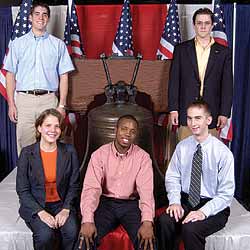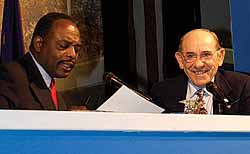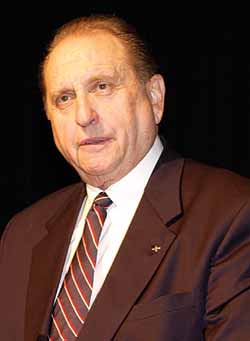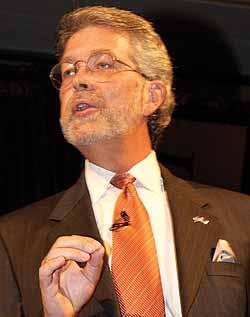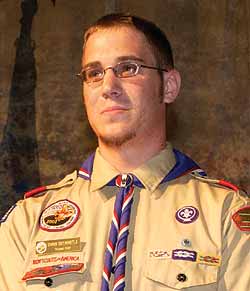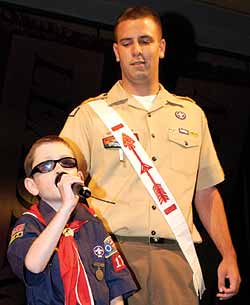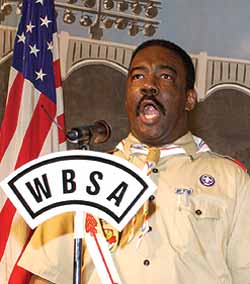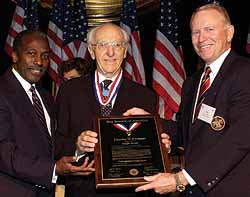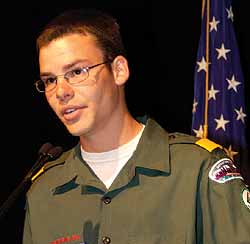![]() September 2003
September 2003
Meeting In Philadelphia
By Jon C. Halter
Photographs By John R. Fulton Jr. And Roger Morgan
In the city where the Founding Fathers provided America's finest examples of citizenship, service, and leadership, Scouters at the BSA National Annual Meeting focused on the best ways to establish those enduring values among today's youth.
- Silver Buffalo Awards
- Honoring an 'American Icon'
- Speakers Cite Scouting's Lifelong Impact
- Highlighted Accomplishments
- They Are the BSA
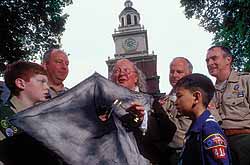 In front of Philadelphia's historic Independence Hall, Ben Franklin (portrayed by Ralph Archbold) describes his kite-flying experiments to Boy Scout Colin Lawlor and Cub Scout Jason Truong, from the host Cradle of Liberty Council; and to (rear, from left) Scouters Chip Clardy, Charlotte, N.C.; Chris Manning, California Inland Empire Council; and Tony Ryan, National Capital Area Council. |
Who better to welcome visitors to Philadelphia than the city's most famous resident of all time, Benjamin Franklin?
And it was the patriot, scientist, statesman, and talented storyteller (in a lifelike portrayal by actor Ralph Archbold) who greeted 2,000 Scouters and spouses in early June at the 84th National Annual Meeting of the Boy Scouts of America.
In his welcoming remarks, Franklin recalled the two most famous meetings ever to take place in his adopted city: the Continental Congress in 1776, which drafted the Declaration of Independence, and the Constitutional Convention of 1787, which created the Federal Constitution.
Both of those historical meetings were held at what was then known as the State House in Philadelphia and is now called Independence Hall. Many Scouters and spouses visited the hallowed landmark, located in Independence National Historical Park, within walking distance from the BSA meeting at the Philadelphia Marriott Hotel.
"What we did [at those two meetings] was [to make] a promise to every one of you, the promise of a free and independent nation, for you and for your children and for your grandchildren," Franklin said.
And now, he declared, "You are about to begin the third great meeting" in Philadelphia.
The reason a BSA annual meeting of Scouting volunteers and professionals, representing more than 300 local councils, merited such prominence was simple, Franklin explained: "You serve the most important people in this world, the young people who are the future, the future of your community, the future of your nation, the future of this world."
And focusing on the best ways to serve those young people, by providing as many of them as possible with Scouting's values-based program of character development and leadership training, was exactly why the Scouters had come to Philadelphia.
Success and challenge
At Friday's annual business meeting, Chief Scout Executive Roy L. Williams reviewed the successes of 2002 and the tasks ahead.
"The challenge for us as leaders of this movement is to provide our fellow volunteers with the resources they need to serve youth," Williams said.
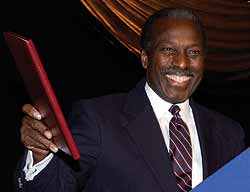 BSA President Roy S. Roberts said Scouting provides youth with "the gift of time." |
This will be best accomplished, he noted, by achieving the goals of the five critical issues in the 2002-2005 National Strategic Plan: (1) Developing strong units, (2) Continuing to reach out to underserved communities, (3) Developing and recruiting the right leadership, (4) Effectively marketing our program and being as visible as possible, and (5) Making sure councils are well financed.
"We made great progress in fulfilling the elements of the plan during the past year," Williams continued. "On the marketing front...we're letting our good deeds speak for us, like Scouting for Food and the thousands of other service projects that happen through Scouting each year...
"In 2002 our program grew, [including] an increase in the number of volunteer leaders, which is very encouraging. And...in the middle of a recession, we had the third-best year ever in terms of commitments to local council endowments."
But while 2002 was a good year, "we have our challenges," Williams pointed out. "First and foremost is the economy. We're in the middle of what some have called a 'nonprofit depression'...but to put things in perspective, across the nation we've had an increase in Friends of Scouting income of almost 4 percent. That's a good sign."
Another major challenge is recruiting more men and women for careers in professional Scouting.
 An appearance by firefighters and Scouts recalled the dedicated service both groups performed following the terrorist attacks of Sept. 11, 2001. |
"Currently, youth-serving executive staffing in councils is down," Williams noted. "We must fill those vacancies or reassign support staff. It's that critical."
Another challenge is transforming into functioning packs, troops, and crews the more than 6,000 commitments that potential chartered organizations pledged during last February's national new-unit campaign.
"No matter what your role in Scouting," Williams urged, "I hope you'll make turning those commitments into units your top priority."
Marketing is another area in need of special attention. "There are thousands of youth and parents out there who will join—if we help them," Williams said. More emphasis on effective communication is necessary, because "research tells us that parents need to see a recruiting message four times before they consider joining."
And the same research reveals that "88 percent of non-Scouting parents say that no one ever talked to them about joining Scouting [and] almost one-third of parents didn't even know if there was a pack or troop in their area."
To conduct successful marketing campaigns, "council marketing committees are a must," Williams emphasized. "Just dropping fliers off at schools won't get it done. Parents [today] have too many [other] choices."
The gift of time
"Over the past 12 months I've visited Scout councils all over this great nation," said BSA President Roy S. Roberts, in reporting on his first year in office. "Everywhere I've been, the support for Scouting has been overwhelming. That's a credit to you, and I want to thank you for what you do for Scouting and for young people."
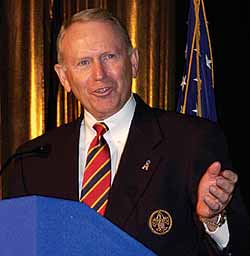 Chief Scout Executive Roy L. Williams outlined the challenges ahead in 2003. |
In today's fast-paced world, many families are under great stress, Roberts noted. "What every parent wants—and every child needs—is time. [But] more and more it seems the hands of the clock are pushing against young people."
Scouting "has a lot to offer children: leadership skills, values, character, fun, and so much more," he declared. "But at its most basic level, Scouting is about time...with a caring adult.
"That's part of the magic of Scouting. For at least an hour a week, boys have our undivided attention. And in that sacred period of time between a child and a caring parent or volunteer leader—whether it's over a service project, on a hike, making a pinewood derby car, or a simple lesson in knot-tying—that's where character is formed."
Since 1910 "more than 110 million young people have worn the Scout uniform," he noted. "[But] we're just getting started [and] there's a lot left for us to do...
"Our job is to help our den leaders and Scoutmasters and other volunteers to deliver the gift of time...[and] with your support and leadership, we'll continue to afford more young people that precious gift."
A chance to learn
Five seminars and 14 elective workshops focused on the tools and methods for achieving the goals of the Strategic Plan's five critical issues. The sessions covered a variety of topics, such as relationships with community organizations, risk management, effective United Way presentations, effective marketing techniques, international Scouting opportunities, effective use of the Venturing program, and a preview of plans for the 2005 National Scout Jamboree.
In the exhibit area, Scouters visited with representatives from the National Council and other sources to learn about all areas of Scouting. Displays included the latest merchandise from the Supply Division; details on Cub Scouting, Boy Scouting, Venturing, high adventure programs, and International Scouting; resources available from Risk Management, Health and Safety, Scoutreach, Relationships, and Finance Support; information on the new National Scouting Museum in Irving, Tex.; and a sampling of the newest features from Boys' Life.
Making a difference
The recognition banquet spotlighted the recipients of the Silver Buffalo Award, the BSA's highest honor for distinguished service to youth at the national level, and the five winners of the national Young American Awards, honoring young people for service, character, and accomplishment.
Old Ben Franklin himself was on hand for the festivities, serving as the evening's master of ceremonies (while reminding everyone that he is just three years shy of his 300th birthday).
"You know, there's a theme running through these award presentations," he observed as the audience saluted the evening's distinguished honorees. "Volunteerism...People who are willing to give of their time, people who are caring, people who are concerned...There are a lot of people here who have made a great deal of difference in the lives of many individuals, and that is the greatest gift we can give."
At the business meeting earlier in the day, Chief Scout Executive Roy Williams had expressed his gratitude to Scouting's countless volunteer leaders for continuing to make a difference in the lives of young people. And he also reminded them that the need for such dedicated service is greater than ever.
"Our mission is clear," Williams said. "We have to do our level best to make Scouting available to every young person in every neighborhood and community, no matter where they live and whether or not they can afford a uniform."
For more than nine decades, "the ideals of Scouting have been a major force in our nation...," he concluded. "And as we help our young people carve their own destinies, Scouting will continue to shape the future of the nation."
Jon C. Halter is the editor of Scouting magazine.
Silver Buffalo AwardsThe BSA honors adult leaders and young people for high achievement and service.
| ||||||||||||||||||
Honoring an 'American Icon'
The Americanism Breakfast, hosted by the National Eagle Scout Association, featured a tribute to baseball legend Yogi Berra, who was honored with the Silver Buffalo Award, the BSA's highest honor for service to youth. In 1991, Berra established the annual Yogi Berra Golf Classic, which has raised more than a million dollars for the Northern New Jersey Council's programs for Scouts with special needs. The Yogi Berra Museum is also a learning center that provides educational programs for thousands of youth. And Berra and his wife, Carmen, have established an endowment fund and a foundation to support Special Needs Scouting and other youth programs. The audience was entertained by Berra's responses to questions from Philadelphia sportscaster, former NFL star, and Eagle Scout Beasley Reece. They particularly enjoyed Berra's good-natured explanations for some of his more memorable quotations—such as "It's déjà vu all over again" and "The future isn't what it used to be"—words whose fame has almost matched his many exploits during a Hall of Fame career as a catcher for the New York Yankees. In presenting the Silver Buffalo Award, Chief Scout Executive Roy L. Williams said that Berra "is a true American legend who believes in the basic values of hard work, common sense, fairness, integrity, and commitment—and his good sense of humor has helped to make him an American icon. Yogi embodies the values of the Scout Oath and Law and all that's great about America." "It's a real honor to receive the Silver Buffalo Award," Berra said in acceptance, adding that "kids are our future—even if the future isn't what it used to be." |
Speakers Cite Scouting's Lifelong ImpactA variety of speakers at the National Annual Meeting testified to the lifelong impact that Scouting involvement can have on an individual. ***
At the Duty to God Breakfast, the meeting's opening event, Thomas S. Monson, First Counselor in The First Presidency, The Church of Jesus Christ of Latter-day Saints, described his experiences more than six decades ago. "Sixty-three years ago I was a Tenderfoot Scout," he said, in vividly recalling his first camping trip in cold and snow. "Our Scoutmaster's name was Carl, and he had only one leg." Monson and his fellow Scouts learned an enduring lesson in leadership from their Scoutmaster on that camp-out, when someone hid Carl's wooden leg and was not punished or admonished upon returning it. "Love is the greatest word in the English language, and serve is the second," Monson observed. "Scouting exemplifies both," he noted, because "It is the mission of the Boy Scouts of America to serve others by offering help, to instill values of the Scout Oath and Law in youth and in others." ***
Friday's Leadership Luncheon featured Randy Pennington, author and expert in leadership, change management, and values-based performance, who discussed the principles in the book he co-authored, On My Honor, I Will... Leading With Integrity in Changing Times. He recalled the values he learned as a member of Troop 317 while growing up in Greenville, Tex. He noted how some in business use the term "he's a real Boy Scout" to imply that a person is "timid or weak, unwilling to do what is necessary to succeed in business." "Don't tell that to an Eagle Scout," he warned, noting that the "real meaning" of the term "is to know what it is like to do whatever you need to succeed but [to] know that you never sacrifice your honor [in doing so]." In posing the question "What would be different if everyone lived the Scout Oath and Law in business?" he presented his formula for creating a "Scout-like culture" in business. "What we're really about [in following this philosophy] is creating a generation of leaders who believe and understand and know in their heart that being 'a real Boy Scout' is the only way to be a long-term success in business and in life." ***
Scouters at Friday's Americanism Breakfast heard from Christopher Entwhistle, Eagle Scout from Troop 69, Northwest Suburban Council, in Mount Prospect, Ill., and winner of the four-year $48,000 Mabel and Lawrence S. Cooke Eagle Scout Scholarship for 2002. The award is the largest of the 105 academic and merit scholarships offered by the National Eagle Scout Association (NESA), providing more than $370,000 annually to assist Eagle Scouts in their educational pursuits. In 2002, regional scholarship committees reviewed more than 3,800 applications from Eagle Scouts across the nation. "Without the experiences I had as a Boy Scout, I would not be the person I am today," Christopher told the breakfast audience. The Cooke scholarship "has permitted me a broader and more fulfilling college experience at the University of Kansas," he added. "I have been able to give my time to the student senate, [at which] I have used many of the leadership, teamwork, communication, and citizenship skills that I learned in the Scouting program...and [those skills] have helped me to excel in the classroom, also... "The foundations of Scouting have stuck with me every day, and will do so throughout my life." |
Highlighted AccomplishmentsThe following are some BSA accomplishments for 2002 highlighted at the National Annual Meeting:
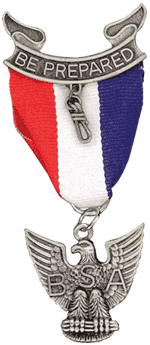
|
They Are the BSA
In addition to the winners of the Silver Buffalo, Silver Antelope, and Young American Awards, Scouters at the National Annual Meeting were introduced to a variety of individuals representing Scouting's many dedicated volunteer leaders and outstanding youth members. Two national youth leaders were regulars at the podium. Order of the Arrow National Chief Nick Digirolamo, an Eagle Scout from Tampa, Fla., led the color guard and gave the invocation at the Americanism Breakfast and helped serve as master of ceremonies at the Leadership Luncheon. National Venturing President Sam Stocker, an Eagle Scout from Royal Oak, Mich., gave the invocation at the Leadership Luncheon and Annual Business Meeting. Two individuals of extraordinary singing ability earned prolonged ovations for their performances. Cub Scout Timmy Kelly, 9, of Pack 174, Philadelphia, is no stranger to the spotlight, having performed at major sporting events, on Good Morning America, and at the Pennsylvania governor's inauguration. He delivered a dazzling performance of "God Bless America" at the Leadership Luncheon. At the Americanism Breakfast, Scoutmaster Aaron Gooding Sr. of Troop 358, Philadelphia, gave a dramatic, soul-stirring rendition of the national anthem.
At the Business Meeting, Chief Scout Executive Roy Williams and BSA President Roy Roberts highlighted several outstanding veteran Scouters and one memorable young man. Col. Mitchell Paige completed the requirements for Eagle Scout in 1936 but his paperwork was never submitted. Enlistment into the Marines took him away, and six years later he was awarded the Congressional Medal of Honor for conspicuous gallantry on Guadalcanal. Earlier in 2003, Colonel Paige finally received his Eagle Scout Award, and at the Business Meeting was honored with the Distinguished Eagle Scout Award. Realizing that boys who cause trouble are often the ones who need help the most, Scoutmaster Dave Farley has led a troop of at-risk youth in Albion, Mich., for five years. He knows that Scouting provides a place to form a meaningful relationship with an adult, a chance many of his Scouts have never had.
Eddie Mancillas was a rebellious 12-year-old gang member when his mother brought him to Scoutmaster James Hanson's troop in Bakersfield, Calif., in an effort to keep him from going to jail. Eddie went on to earn the rank of Life Scout and later became an assistant Scoutmaster, certified NRA rifle instructor, camp director, restaurant manager, and law student. When Scoutmaster Henry Craft, Troop 115, Hattiesburg, Miss., earned his Eagle Scout Award in 1947, he promised himself that he'd never get out of Scouting. During a 21-year Army career, he started troops on U.S. military bases from France to the Philippines. Today, at 69, he's helping start Scoutreach units in Hattiesburg. During his many years as a Scout leader, Craft has had 26 Eagles—nine have become ministers, three are college professors, one's a lawyer, and two became doctors.
Illness kept one outstanding youth member, Boy Scout Zachary Gomez, of San Angelo, Tex., from appearing. Zachary had to join Cub Scouting three times before he found a pack that wouldn't fold and was willing to make room for him. As a Webelos Scout, he received the BSA Meritorious Action Award for organizing a collection drive for a women's and children's shelter in his town, an effort that has become an annual community event. Now a First Class Scout, Zachary was chosen to be part of the BSA Report to the Nation delegation in February and met President George W. Bush. In Philadelphia, Scouters wished him well by signing messages of encouragement on giant get-well postcards. |
September 2003 Table of Contents
Copyright © 2003 by the Boy Scouts of America. All rights thereunder reserved; anything appearing in Scouting magazine or on its Web site may not be reprinted either wholly or in part without written permission. Because of freedom given authors, opinions may not reflect official concurrence.
| The Boy Scouts of America | http://www.scouting.org |











